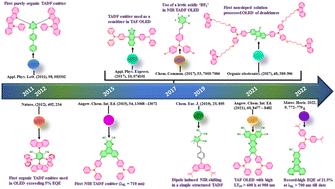Recent advances of NIR-TADF (λ maxPL/EL > 700 nm) emitters and their applications in OLEDs
Abstract
The rise of organic thermally activated delayed fluorescence (TADF) materials as NIR emitters and hosts have engrossed wide consideration as they can demonstrate 100% internal quantum efficiency. These materials have exceeded the phosphorescent noble-metal complexes due to cost-efficiency without compromising the OLED performance. Numerous applications of the NIR spectrum, e.g., in telecommunication, night-vision display, biomedical applications, and chemical sensors, render the NIR-TADF emitters vulnerable to evolution. This review highlights the various strategies adopted in the recent past (2015–2022) to judiciously design purely organic NIR-TADF emitters (λmaxPL/EL > 700 nm) with in-depth discussions of photophysical and device-electroluminescence studies. Approaches such as the incorporation of extended π-conjugated acceptors, diazoles of group-16 elements, ‘BF2’-acceptor, non-conjugated donor–acceptor dendrons, exciplex formation, and TADF sensitization provide effective pathways to construct high-efficiency NIR-TADF-OLEDs. Thus, this review aims to provide a new perspective for the next generation researchers to implement strategies for the thoughtful design of efficient NIR-TADF materials.

- This article is part of the themed collection: Journal of Materials Chemistry C Recent Review Articles


 Please wait while we load your content...
Please wait while we load your content...